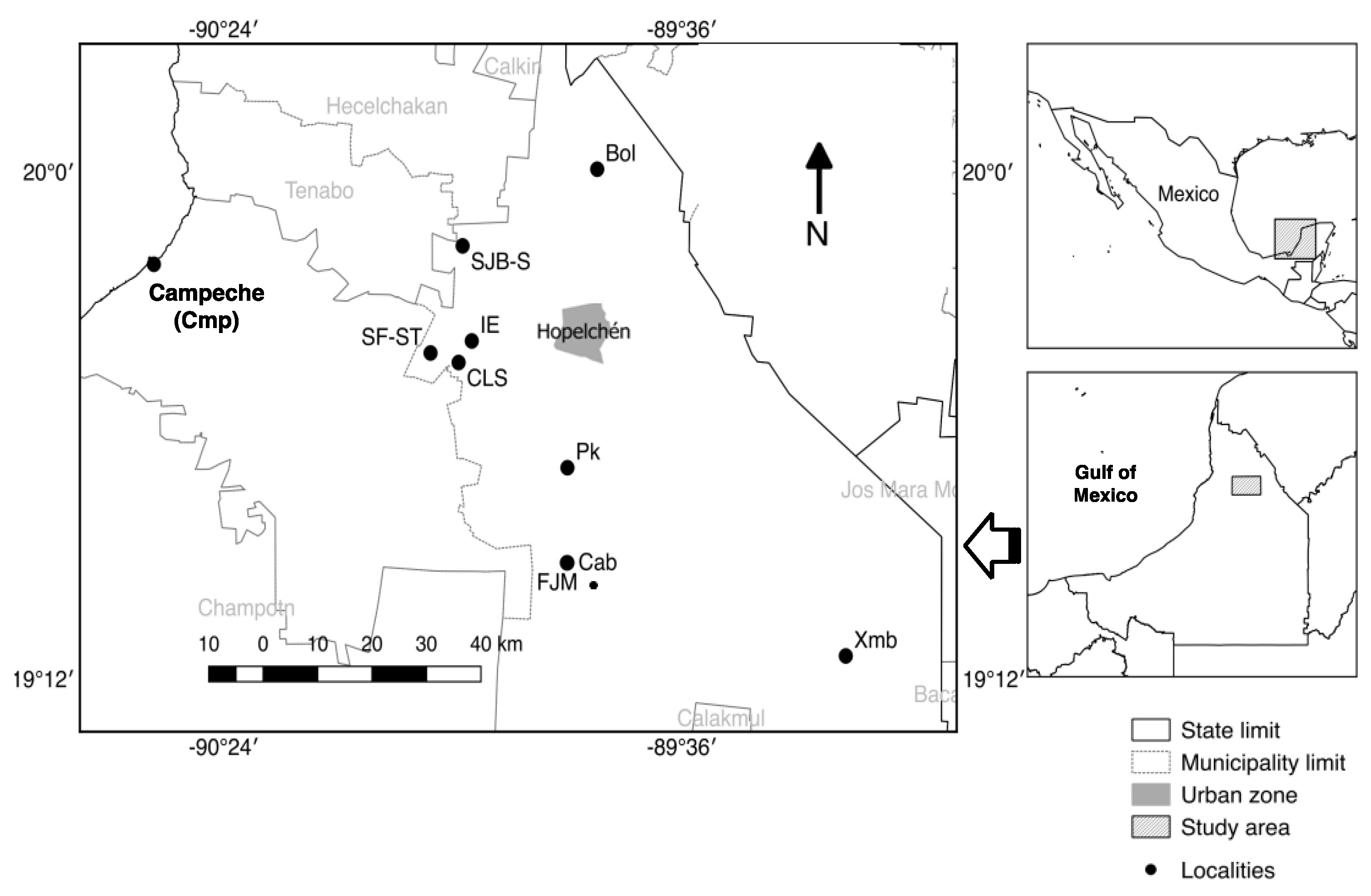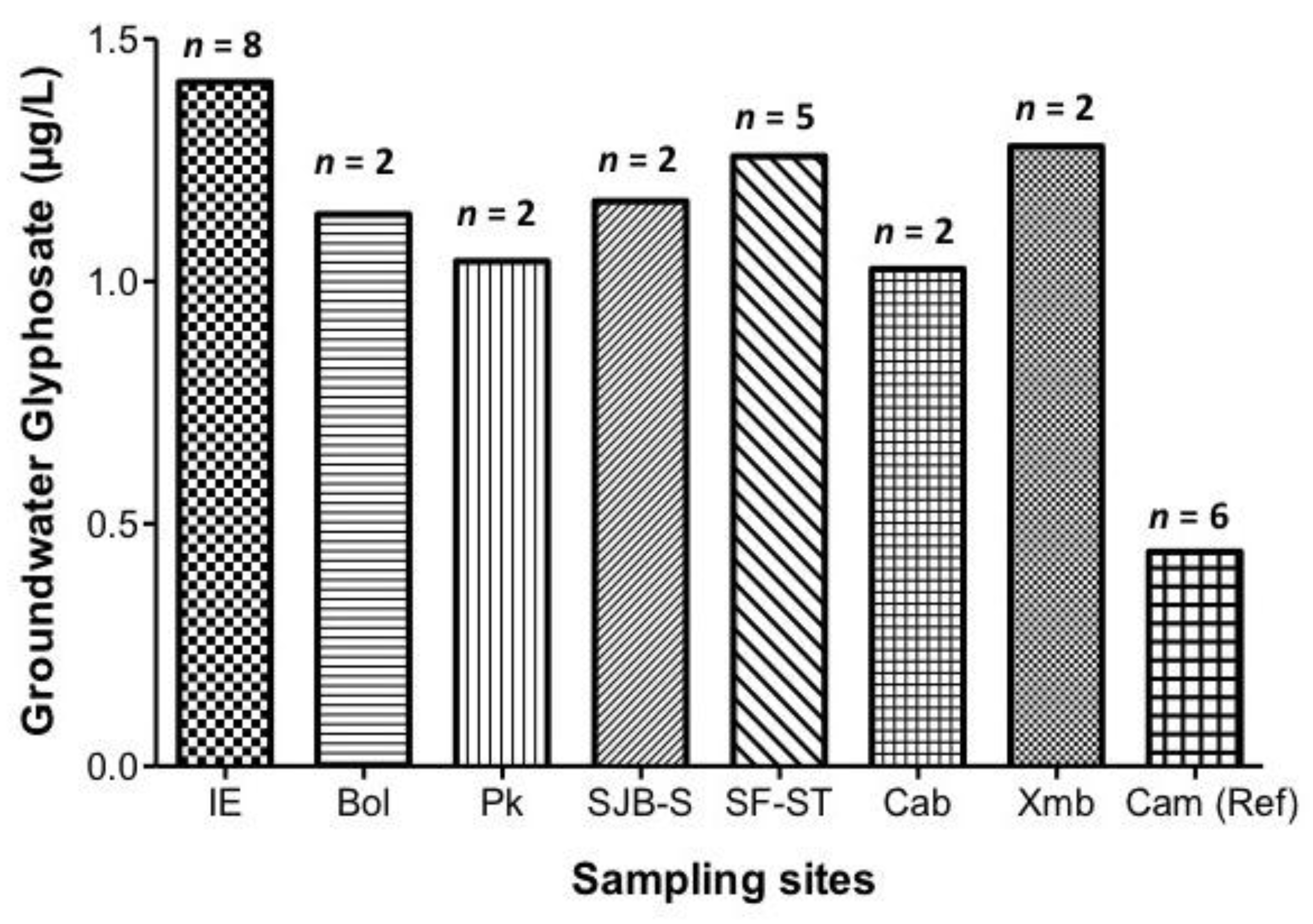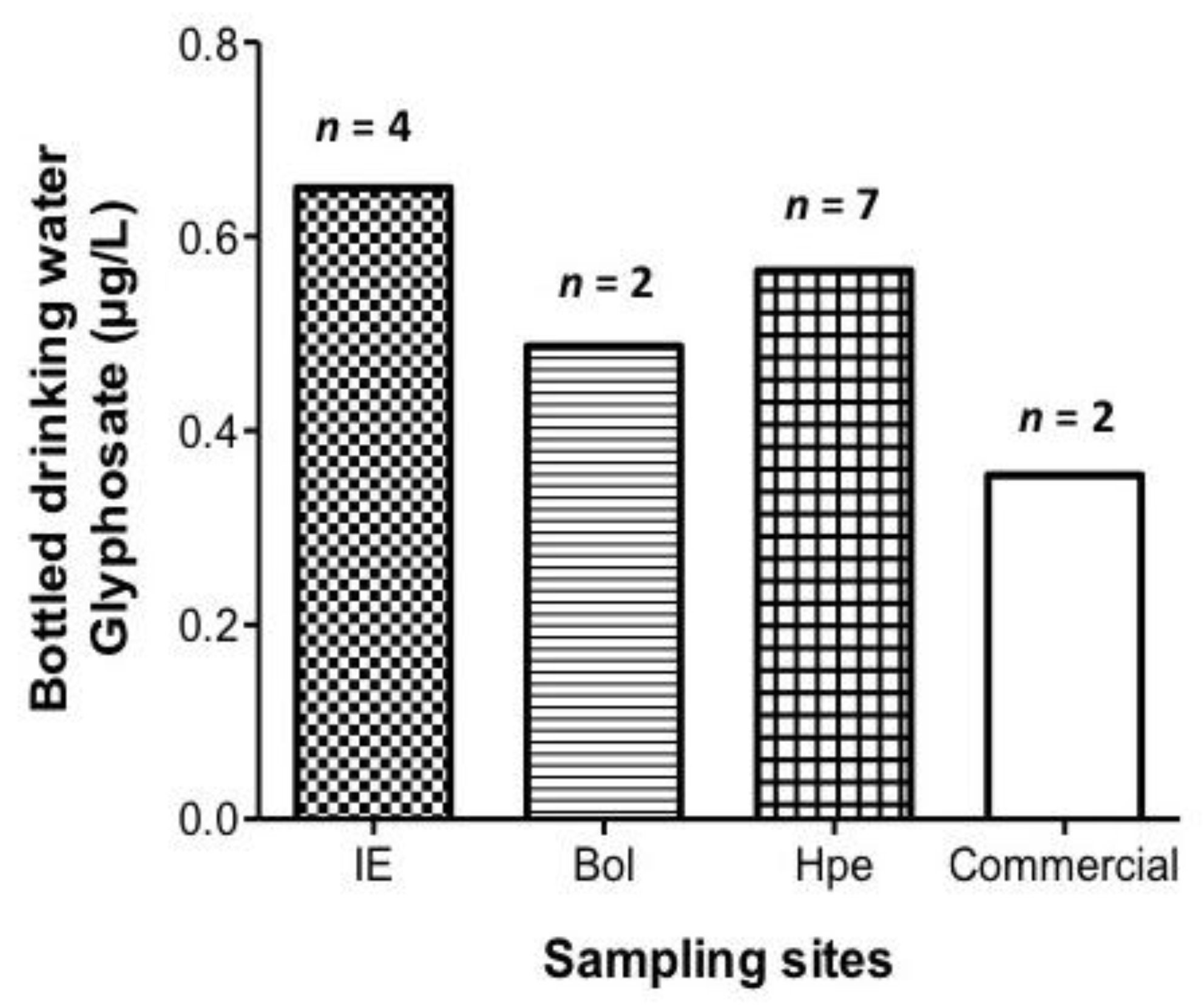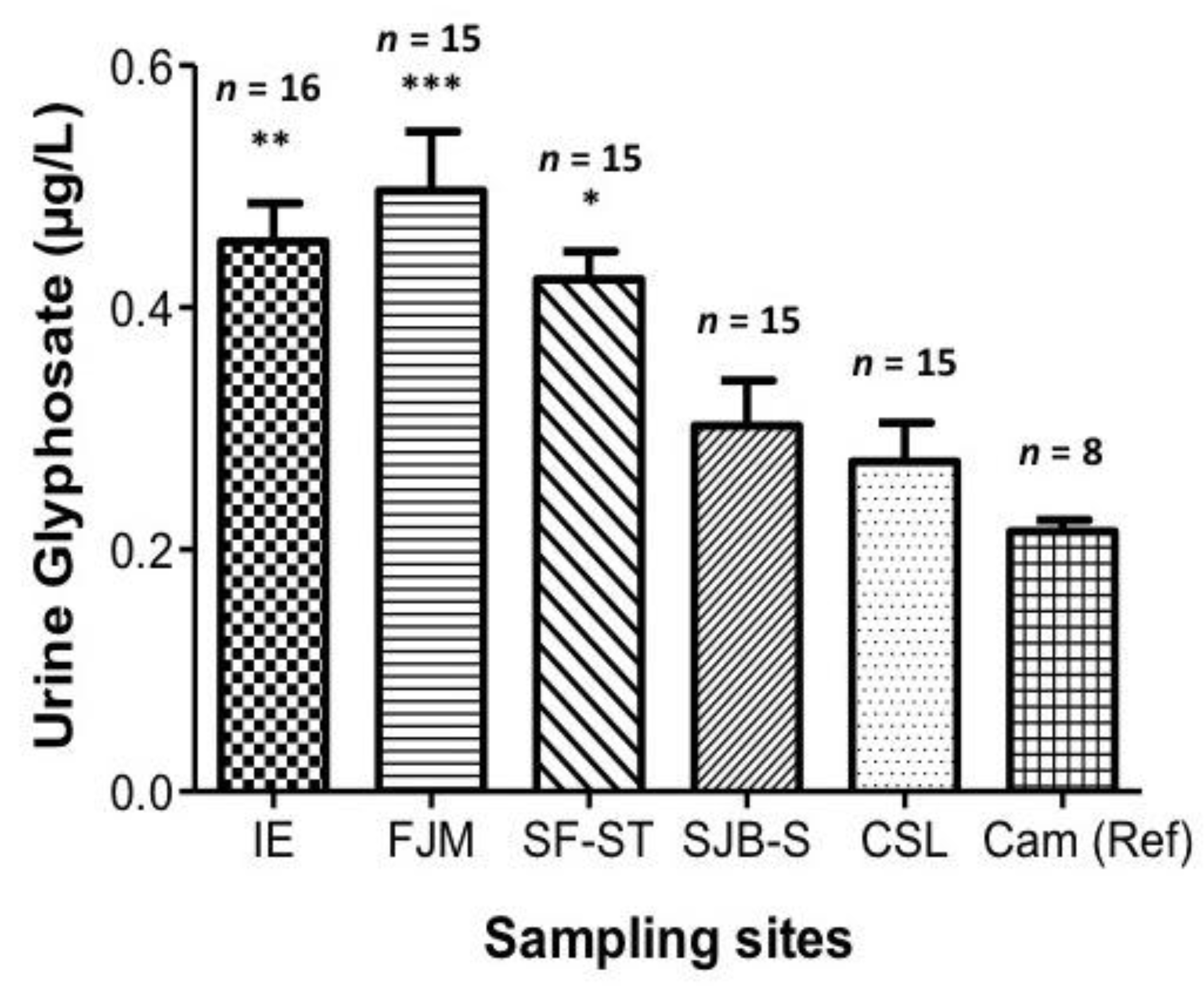Glyphosate Residues in Groundwater, Drinking Water and Urine of Subsistence Farmers from Intensive Agriculture Localities: A Survey in Hopelchén, Campeche, Mexico
Abstract
1. Introduction
2. Materials and Methods
2.1. Study Sites and Sample Collection
2.2. Water Sample Collection
2.3. Urine Sample Participants
2.4. Glyphosate Analysis by ELISA
2.5. Statistical Analysis
3. Results
3.1. Glyphosate in Groundwater
3.2. Glyphosate in Bottled Drinking Water
3.3. Glyphosate in Human Urine
4. Discussion
4.1. Residual Levels of Glyphosate in Groundwater Samples with Intense Agricultural Activity
4.2. Residual Levels of Glyphosate in Bottled Drinking Water Samples
4.3. Residual Levels of Glyphosate in Human Urine Samples
5. Conclusions
Supplementary Materials
Acknowledgments
Author Contributions
Conflicts of Interest
References
- Instituto Nacional de Estadística y (INEGI). El Sector Alimentario en México 2014; Series Estadísticas Sectoriales; Instituto Nacional de Estadística y Geografía: Aguascalientes, México, 2014; 304p. (In Spanish) [Google Scholar]
- Secretaría de Agricultura, Gandería, Desarrollo Rural, Pesca y Alimentación (SAGARPA), 2015. Servicio de Información Agroalimentaria y Pesquera. Available online: http://www.siap.gob.mx (accessed on 20 March 2017).
- Echanove-Huacuja, F. La expansión del cultivo de la soja en Campeche, México: Problemática y perspectivas. An. Geogr. Univ. Complut. 2016, 36, 49–70. [Google Scholar] [CrossRef]
- Secretaría de Agricultura, Gandería, Desarrollo Rural, Pesca y Alimentación (SAGARPA). Delegación en Campeche, Padrón de Productores de Soja 2013; Secretaría de Agricultura, Gandería, Desarrollo Rural, Pesca y Alimentación: Ciudad de México, México, 2015.
- Lakhani, N. Sweet Victory for Mexico Beekeepers as Monsanto Loses GM Permit. The Guardian. Available online: https://www.theguardian.com/global-development/poverty-matters/2014/aug/08/sweet-victory-beekeepers-monsanto-gm-soybeans (accessed on 25 January 2017).
- Villanueva-Gutiérrez, R.; Echazarreta-González, C.; Roubik, D.W.; Moguel-Ordóñez, Y.B. Transgenic soybean pollen (Glycine max L.) in honey from the Yucatán peninsula, Mexico. Sci. Rep. 2014, 4022, 1–4. [Google Scholar] [CrossRef] [PubMed]
- Ellis, E.A.; Romero Montero, A.; Hernández Gómez, I.U. Evaluación y mapeo de los determinantes de deforestación en la Península Yucatán. Agencia de los Estados Unidos para el Desarrollo Internacional (USAID); The Nature Conservancy (TNC); Alianza México REDD+: Distrito Federal, México, 2015; Available online: https://www.researchgate.net/profile/Edward_Ellis/publication/283090392_Evaluacion_y_mapeo_de_los_determinantes_de_la_deforestacion_en_la_Peninsula_Yucatan-USAIDTNCMREDD/links/562a7d7808ae518e347f54dc.pdf (accessed on 16 March 2017).
- Comisión Nacional del Agua (CONAGUA). Programa Hídrico Regional Visión 2030. Región Hidrológico-Administrativa XII Península de Yucatán. SEMARNAT, 2012. Available online: http://www.conagua.gob.mx/conagua07/publicaciones/publicaciones/12-sgp-17-12py.pdf (accessed on 9 March 2017).
- Rivera, J. Herbicida de Monsanto se Propaga Por Agua y Suelos de la Península. Available online: http://www.elquintanaroo.mx/wp/monsanto-envenena-acuiferos-yucatecos-con-mas-de-13-mil-toneladas-de-herbicida)/ (accessed on 5 December 2016).
- Rendón-von Osten, J.; Benítez-Torres, J.A. Diagnóstico Integral de las Fuentes de Abastecimiento del Estado de Campeche. Informe Final; Instituto EPOMEX-Universidad Autónoma de Campeche y Gobierno del Estado de Campeche: Campeche, Mexico, 2010; pp. 1–97. (In Spanish) [Google Scholar]
- Mercurio, P.; Flores, F.; Mueller, J.F.; Carter, S.; Negri, A.P. Glyphosate persistence in seawater. Mar. Pollut. Bull. 2014, 85, 385–390. [Google Scholar] [CrossRef] [PubMed]
- Ruiz-Toledo, J.; Castro, R.; Rivero-Pérez, N.; Bello-Mendoza, R.; Sánchez, D. Occurrence of Glyphosate in Water Bodies Derived from Intensive Agriculture in a Tropical Region of Southern Mexico. Bull. Environ. Contam. Toxicol. 2014, 93, 289–293. [Google Scholar] [CrossRef] [PubMed]
- Kaiser, K. Preliminary study of pesticide drift into the Maya Mountain protected areas of Belize. Bull. Environ. Contam. Toxicol. 2011, 86, 56–59. [Google Scholar] [CrossRef] [PubMed]
- Rendón-von Osten, J.; Tinoco-Ojanguren, R.; Soares, A.M.V.M.; Guilhermino, L. Effect of pesticide exposure on acetylcholinesterase activity in subsistence farmers from Campeche, Mexico. Arch. Environ. Health 2004, 59, 428–435. [Google Scholar] [CrossRef]
- Duke, S.O.; Powles, S.B. Glyphosate: A once-in-a-century herbicide. Pest Manag. Sci. 2008, 64, 319–325. [Google Scholar] [CrossRef] [PubMed]
- Samsel, A.; Seneff, S. Glyphosate’s Suppression of Cytochrome P450 Enzymes and Amino Acid Biosynthesis by the Gut Microbiome: Pathways to Modern Diseases. Entropy 2013, 15, 1417–1463. [Google Scholar] [CrossRef]
- Mineau, P.; Harding, K.M.; Whiteside, M.; Fletcher, M.R.; Garthwaite, D.; Knopper, L.D. Using Reports of Bee Mortality in the Field to Calibrate Laboratory-Derived Pesticide Risk Indices. Environ. Entomol. 2008, 37, 546–554. [Google Scholar] [CrossRef] [PubMed]
- Pimentel, D. Environmental and economic costs of the application of pesticides primarily in the United States? Environ. Dev. Sustain. 2005, 7, 229–252. [Google Scholar] [CrossRef]
- Vandame, R. Uso de plaguicidas y mortalidad de abejas en México: Una creciente urgencia. El Jarocho Cuánt. 2016, 65, 5. Available online: http://www.jornadaveracruz.com.mx/extras/20168/160806_999.pdf (accessed on 14 March 2017).
- Boily, M.; Sarrasin, B.; Deblois, C.; Aras, P.; Chagnon, M. Acetylcholinesterase in honey bees (Apis mellifera) exposed to neonicotinoids, atrazine and glyphosate: Laboratory and field experiments. Environ. Sci. Pollut. Res. Int. 2013, 20, 5603–5614. [Google Scholar] [CrossRef] [PubMed]
- European Food Safety Authority (EFSA). Conclusion on the peer review of the pesticide risk assessment of the active substance glyphosate. EFSA J. 2015, 13. [Google Scholar] [CrossRef]
- Guyton, K.Z.; Loomis, D.; Grosse, Y.; El Ghissassi, F.; Benbrahim-Tallaa, L.; Guha, N.; Scoccianti, C.; Mattock, H.; Straif, K. Carcinogenicity of tetrachlorvinphos, parathion, malathion, diazinon, and glyphosate. Lancet Oncol. 2015, 16, 490–491. [Google Scholar] [CrossRef]
- Williams, G.M.; Kroes, R.; Munro, I.C. Safety evaluation and risk assessment of the herbicide Roundup and its active ingredient, glyphosate, for humans. Regul. Toxicol. Pharmacol. 2000, 31, 117–165. [Google Scholar] [CrossRef] [PubMed]
- Walsh, L.P.; McCormick, C.; Martin, C.; Stocco, D.M. Roundup inhibits steroidogenesis by disrupting steroidogenic acute regulatory (STAR) protein expression. Environ. Health Perspect. 2000, 108, 769–776. [Google Scholar] [CrossRef] [PubMed]
- Daruich, J.; Zirulnik, F.; Gimenez, M.S. Effect of the herbicide glyphosate on enzymatic activity in pregnant rats and their fetuses. Environ. Res. 2001, 85, 226–231. [Google Scholar] [CrossRef] [PubMed]
- Richard, S.; Moslemi, S.; Sipahutar, H.; Benachour, N.; Seralini, G.E. Differential effects of glyphosate and roundup on human placental cells and aromatase. Environ. Health. Perspect. 2005, 113, 716–720. [Google Scholar] [CrossRef] [PubMed]
- Marc, J.; Mulner-Lorillon, O.; Boulben, S.; Hureau, D.; Durand, G.; Belle, R. Pesticide Roundup provokes cell division dysfunction at the level of CDK1/cyclin B activation. Chem. Res. Toxicol. 2002, 15, 326–331. [Google Scholar] [CrossRef] [PubMed]
- Barbosa, E.R.; Leiros da Costa, M.D.; Bacheschi, L.A.; Scaff, M.; Leite, C.C. Parkinsonism after glycine-derivative exposure. Mov. Disord. 2001, 16, 565–568. [Google Scholar] [CrossRef] [PubMed]
- Acquavella, J.F.; Alexander, B.H.; Mandel, J.S.; Gustin, C.; Baker, B.; Chapman, P.; Bleeke, M. Glyphosate biomonitoring for farmers and their families: Results from the farm family exposure study. Environ. Health Perspect. 2004, 112, 321–326. [Google Scholar] [CrossRef] [PubMed]
- Takahashi, M.; Horie, M.; Aoba, N. Analysis of glyphosate and its metabolite, aminomethylphosphenic acid, in agricultural products by HPLC. Shokuhin Eiseigaku Zasshi 2001, 42, 304–308. [Google Scholar] [CrossRef] [PubMed]
- Liu, G.; Peng, Z.; Lan, T.; Xu, X.; Huang, G.; Yu, S.; Liu, G.; Li, J. Health risk assessment on pesticide residues in drinking water in Shenzhen. Wei Sheng Yan Jiu 2015, 44, 264–269. [Google Scholar] [PubMed]
- Jayasumana, C.; Gunatilake, S.; Senanayake, P. Glyphosate, hard water and nephrotoxic metals: Are they the culprits behind the epidemic of chronic kidney disease of unknown etiology in Sri Lanka? Int. J. Environ. Res. Public Health 2014, 11, 2125–2147. [Google Scholar] [CrossRef] [PubMed]
- Curwin, B.D.; Hein, M.J.; Sanderson, W.T.; Striley, S.; Heederik, D.; Kromhout, H.; Reynolds, S.J.; Alavanja, M.C. Urinary pesticide concentrations among children, mothers and fathers living in farm and non-farm households in Iowa. Ann. Occup. Hyg. 2006, 51, 53–65. [Google Scholar] [CrossRef] [PubMed]
- Krüger, M.; Schledorn, P.; Schrödl, W.; Hoppe, H.W.; Lutz, W.; Shehata, A.A. Detection of Glyphosate Residues in Animals and Humans. J. Environ. Anal. Toxicol. 2014, 4. [Google Scholar] [CrossRef]
- Niemann, L.; Sieke, C.; Pfeil, R.; Solecki, R. A critical review of glyphosate findings in human urine samples and comparison with the exposure of operators and consumers. J. Verbr. Lebensm. 2015, 10, 3–12. [Google Scholar] [CrossRef]
- Ruiz-Toledo, J.; Sánchez-Guillén, D. Effect of the concentration of glyphosate present in body waters near transgenic soybean fields on the honeybee Apis mellifera, and the stingless bee Tetragonisca angustula. Acta Zool. Mex. 2014, 30, 408–413. [Google Scholar]
- Balbuena, M.S.; Tison, L.; Hahn, M.L.; Greggers, U.; Menzel, R.; Farina, W.M. Effects of sublethal doses of glyphosate on honeybee navigation. J. Exp. Biol. 2015, 218, 2799–2805. [Google Scholar] [CrossRef] [PubMed]
- Lermen, D.; Bartel-Steinbach, M.; Jost, N. German Environmental Specimen Bank (ESB)—Guideline for Sampling and Sample Processing 24h-Sampling Urine; Fraunhofer Institute for Biomedical Engineering IBMT: Sulzbach, Germany, 2015. Available online: https://www.umweltprobenbank.de/en/documents/publications/23843 (accessed on 16 March 2016).
- Glyphosate ELISA Microtiter Plate. Available online: http://www.abraxiskits.com/wp-content/uploads/2016/06/Glyphosate-Plate-Insert-rev053116.pdf (accessed on 7 September 2016).
- Byer, J.D.; Struger, J.; Klawunn, P.; Todd, A.; Sverko, E. Low cost monitoring of glyphosate in surface waters using the ELISA method: An evaluation. Environ. Sci. Technol. 2008, 42, 6052–6057. [Google Scholar] [CrossRef] [PubMed]
- Clegg, B.S.; Stephenson, G.R.; Hall, J.C. Development of an enzyme linked immunosorbent assay for the detection of glyphosate. J. Agric. Food. Chem. 1999, 47, 5031–5037. [Google Scholar] [CrossRef] [PubMed]
- Rubio, F.; Veldhuis, L.J.; Clegg, B.S.; Fleeker, J.R.; Hall, J.C. Comparison of a direct ELISA and an HPLC method for glyphosate determinations in water. J. Agric. Food. Chem. 2003, 51, 691–696. [Google Scholar] [CrossRef] [PubMed]
- Krüger, M.; Schröd, W.; Neuhaus, J.; Shehataer, A.A. Field Investigations of Glyphosate in Urine of Danish Dairy Cows. J. Environ. Anal. Toxicol. 2013, 3. [Google Scholar] [CrossRef]
- Mörtl, M.; Németha, G.; Juracseka, J.; Darvasa, B.; Kampb, L.; Rubio, F.; Székács, A. Determination of glyphosate residues in Hungarian water samples by immunoassay. Microchem. J. 2013, 107, 143–151. [Google Scholar] [CrossRef]
- Arregui, M.C.; Lenardón, A.; Sanchez, D.; Maitre, M.I.; Scotta, R.; Enrique, S. Monitoring glyphosate residues in transgenic glyphosate-resistant soybean. Pest Manag. Sci. 2004, 60, 163–166. [Google Scholar] [CrossRef] [PubMed]
- Sanchís, J.; Kantiani, L.; Llorca, M.; Rubio, F.; Ginebreda, A.; Josep Fraile, J.; Garrido, T.; Farré, M. Determination of glyphosate in groundwater samples using an ultrasensitive immunoassay and confirmation by on-line solid-phase extraction followed by liquid chromatography coupled to tandem mass spectrometry. Anal. Bioanal. Chem. 2012, 402, 2335–2345. [Google Scholar] [CrossRef] [PubMed]
- Kolpin, D.W.; Schnoebelen, D.J.; Thurman, E.M. Degradates provide insight to spatial and temporal trends of herbicides in groundwater. Ground Water 2004, 42, 601–608. [Google Scholar] [CrossRef] [PubMed]
- European Glyphosate Task Force (GTF). Glyphosate Facts. Ground Water Quality and Glyphosate. Available online: http://www.glyphosate.eu/ground-water-quality-and-glyphosate (accessed on 1 April 2017).
- Davis, A.M.; Thorburn, P.J.; Lewis, S.E.; Bainbridge, Z.T.; Attard, S.J.; Milla, R.; Brodie, J.E. Environmental impacts of fully irrigated sugarcane production: Herbicide run-off dynamics from farms and associated drainage systems. Agric. Ecosyst. Environ. 2011, 180, 123–135. [Google Scholar] [CrossRef]
- Van Stempvoort, D.R.; Spoelstra, J.; Senger, N.D.; Brown, S.J.; Post, R.; Struger, J. Glyphosate residues in rural groundwater, Nottawasaga River Watershed, Ontario, Canada. Pest Manag. Sci. 2016, 72, 1862–1872. [Google Scholar] [CrossRef] [PubMed]
- Peruzzo, P.J.; Porta, A.A.; Ronco, A.E. Levels of glyphosate in surface waters, sediments and soils associated with direct sowing soybean cultivation in north Pampasic region of Argentina. Environ. Pollut. 2008, 156, 61–66. [Google Scholar] [CrossRef] [PubMed]
- Cerdeira, A.L.; Gazziero, D.L.P.; Duke, S.O.; Matallo, M.B. Agricultural impacts of glyphosate-resistant soybean cultivation in South America. J. Agric. Food Chem. 2011, 59, 5799–5807. [Google Scholar] [CrossRef] [PubMed]
- Giesy, J.P.; Dobson, S.; Solomon, K.R. Ecotoxicological risk assessment for roundup herbicide. Rev. Environ. Contam. Toxicol. 2000, 167, 35–120. [Google Scholar]
- Busse, M.D.; Ratcliff, A.W.; Shestak, C.J.; Powers, R.F. Glyphosate toxicity and the effects of long-term vegetation control on soil microbial communities. Soil Biol. Biochem. 2001, 33, 1777–1789. [Google Scholar] [CrossRef]
- Vereecken, H. Mobility and leaching of glyphosate: A review. Pest Manag. Sci. 2005, 61, 1139–1151. [Google Scholar] [CrossRef] [PubMed]
- Borggaard, O.K.; Gimsing, A.L. Fate of glyphosate in soil and the possibility of leaching to ground and surface waters: A review. Pest Manag. Sci. 2008, 64, 441–456. [Google Scholar] [CrossRef] [PubMed]
- Schilling, K.E.; Helmers, M. Tile drainage as karst: Conduit flow and diffuse flow in a tile-drained watershed. J. Hydrol. 2008, 349, 291–301. [Google Scholar] [CrossRef]
- Bauer-Gottwe, P.; Gondwe, B.R.N.; Charvet, G.; Marín, L.E.; Rebolledo-Vieyra, M.; Merediz-Alonso, G. Review: The Yucatán Peninsula karst aquifer, Mexico. Hydrogeol. J. 2011, 19, 507–524. [Google Scholar] [CrossRef]
- Scribner, E.A.; Battaglin, W.A.; Gilliom, R.J.; Meyer, M.T. Concentrations of Glyphosate, Its Degradation Product, Aminomethylphosphonic Acid, and Glufosinate in Ground- and Surface-Water, Rainfall, and Soil Samples Collected in the United States, 2001–06. U.S. Geological Survey: Reston, VA, USA, 2007; 111p. Available online: https://pubs.usgs.gov/sir/2007/5122/pdf/SIR2007-5122.pdf (accessed on 22 March 2017).
- Van Stempvoort, D.R.; Roy, J.W.; Brown, S.J.; Bickerton, G. Residues of the herbicide glyphosate in Riparian groundwater in urban catchaments. Chemosphere 2014, 95, 455–463. [Google Scholar] [CrossRef] [PubMed]
- Horth, H.; Blackmore, K. Survey of Glyphosate and AMPA in Groundwaters and Surface Waters in Europe; WRC Report No. UC8073.02; WRc plc: Swindon, UK, 2009. [Google Scholar]
- Kjaer, J.; Ernsten, V.; Jacobsen, O.H.; Hansen, N.; de Jonge, L.W.; Olsen, P. Transport modes and pathways of the strongly sorbing pesticides glyphosate and pendimethalin through structured drained soils. Chemosphere 2011, 84, 471–479. [Google Scholar] [CrossRef] [PubMed]
- Landry, D.; Dousset, S.; Fournier, J.C.; Andreux, F. Leaching of glyphosate and AMPA under two soil management practices in Burgundy vineyards (VosneRomanée, 21-France). Environ. Pollut. 2005, 138, 191–200. [Google Scholar] [CrossRef] [PubMed]
- Chang, F.C.; Simcik, M.F.; Capel, P.D. Occurrence and fate of the herbicide glyphosate and its degradate aminomethylphosphonic acid in the atmosphere. Environ. Toxicol. Chem. 2011, 30, 548–555. [Google Scholar] [CrossRef] [PubMed]
- The Council of the European Union. Council Directive 98/83/EC of 3 November 1998 on the Quality of Water Intended for Human Consumption. Off. J. Eur. Communities 1998, L330, 32–54. [Google Scholar]
- Norma Oficial Mexicana NOM-201-SSA1-2015, Productos y servicios. Agua y Hielo Para Consumo Humano, Envasados y a Granel. Especificaciones Sanitarias. Available online: http://dof.gob.mx/nota_detalle.php?codigo=5420977&fecha=22/12/2015 (accessed on 1 March 2017).
- Benachour, N.; Séralini, G.E. Glyphosate formulations induce apoptosis and necrosis in human umbilical, embryonic, and placental cells. Chem. Res. Toxicol. 2009, 22, 97–105. [Google Scholar] [CrossRef] [PubMed]
- Relyea, R.A. The lethal impact of Roundup on aquatic and terrestrial amphibians. Ecol. Appl. 2005, 15, 1118–1124. [Google Scholar] [CrossRef]
- Solomon, K.; Thompson, D. Ecological risk assessment for aquatic organisms from over-water uses of glyphosate. J. Toxicol. Environ. Health B Crit. Rev. 2013, 6, 289–324. [Google Scholar] [CrossRef] [PubMed]
- Rzymski, P.; Klimaszyk, P.; Kubacki, T.; Poniedziałek, B. The effect of glyphosate-based herbicide on aquatic organisms—A case study. Limnol. Rev. 2013, 4, 215–220. [Google Scholar] [CrossRef]




| Localities | ID | Coordinates | Samples | |||
|---|---|---|---|---|---|---|
| Latitude N | Longitude W | Ground Water | Bottled Drinking Water | Urine | ||
| n = 29 | n = 15 | n = 84 | ||||
| Ich-Ek | IE | 19°43′59.8″ | 89°58.0′0.1″ | 8 | 4 | 16 |
| Bolonchén | Bol | 20°00′150″ | 89°44′51.0″ | 2 | 2 | |
| Pakchén | Pk | 19°31′58.8″ | 89°47′60.0″ | 2 | ||
| SJB Sahcabchén | SJB-S | 19°52′58.8″ | 89°58′58.8″ | 2 | 15 | |
| SF Suc-Tuc | SF-ST | 19°42′50.4″ | 90°02′20.4″ | 5 | 15 | |
| Cancabchén | Cab | 19°22′59.8″ | 89°47′60.0″ | 2 | ||
| Xmaben | Xmb | 19°14′09.6″ | 89°18′50.4″ | 2 | ||
| Francisco J. Mújica | F.J.M. | 19°18′43.5″ | 89°44′22.5″ | 15 | ||
| Crucero San Luis | CSL | 19°41′56.4″ | 89°59′24.0″ | 15 | ||
| Hopelchén | Hp | 19°44′41.0″ | 89°50′42.0″ | 7 * | ||
| Campeche (** Ref) | Cmp | 19°50′55.0″ | 90°31′31.0″ | 6 | 2 | 8 |
© 2017 by the authors. Licensee MDPI, Basel, Switzerland. This article is an open access article distributed under the terms and conditions of the Creative Commons Attribution (CC BY) license (http://creativecommons.org/licenses/by/4.0/).
Share and Cite
Rendon-von Osten, J.; Dzul-Caamal, R. Glyphosate Residues in Groundwater, Drinking Water and Urine of Subsistence Farmers from Intensive Agriculture Localities: A Survey in Hopelchén, Campeche, Mexico. Int. J. Environ. Res. Public Health 2017, 14, 595. https://doi.org/10.3390/ijerph14060595
Rendon-von Osten J, Dzul-Caamal R. Glyphosate Residues in Groundwater, Drinking Water and Urine of Subsistence Farmers from Intensive Agriculture Localities: A Survey in Hopelchén, Campeche, Mexico. International Journal of Environmental Research and Public Health. 2017; 14(6):595. https://doi.org/10.3390/ijerph14060595
Chicago/Turabian StyleRendon-von Osten, Jaime, and Ricardo Dzul-Caamal. 2017. "Glyphosate Residues in Groundwater, Drinking Water and Urine of Subsistence Farmers from Intensive Agriculture Localities: A Survey in Hopelchén, Campeche, Mexico" International Journal of Environmental Research and Public Health 14, no. 6: 595. https://doi.org/10.3390/ijerph14060595
APA StyleRendon-von Osten, J., & Dzul-Caamal, R. (2017). Glyphosate Residues in Groundwater, Drinking Water and Urine of Subsistence Farmers from Intensive Agriculture Localities: A Survey in Hopelchén, Campeche, Mexico. International Journal of Environmental Research and Public Health, 14(6), 595. https://doi.org/10.3390/ijerph14060595





